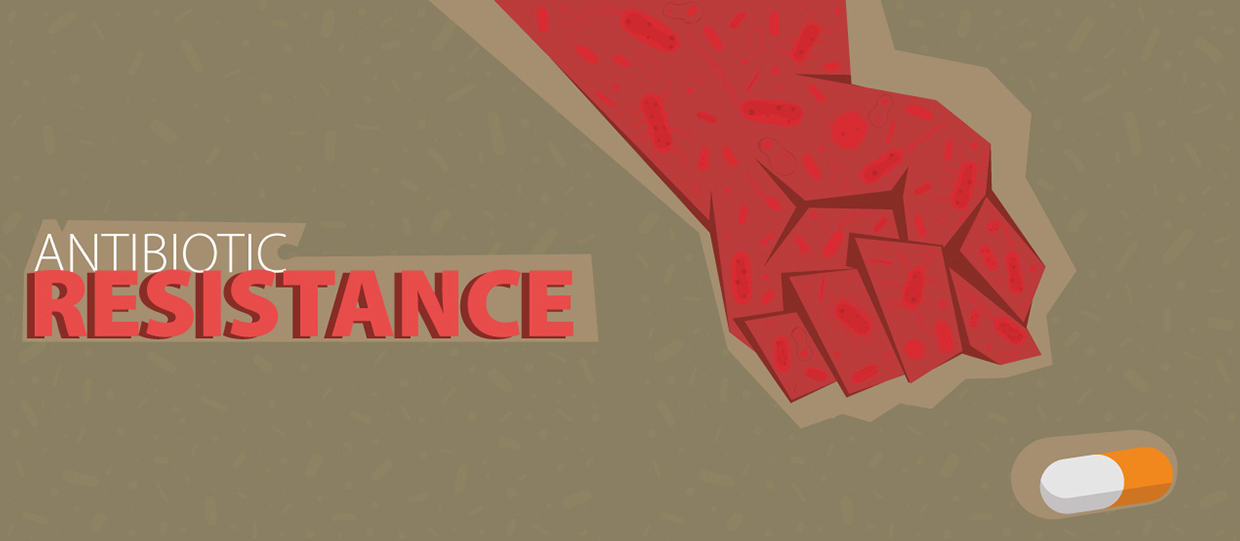Short about antibiotics
Most of us have sometime had the need to take antibiotics to get rid of some bacterial infection. Antibiotics work by killing bacteria or preventing them from spreading. There are a lot of different types of antibiotics, and they work through different mechanisms. There are antibiotics that target cell wall synthesis, protein synthesis, DNA replication and nucleic acid synthesis [1]. If you are very interested, here is a nice image that states which antibiotics that targets what. It also shows some common antibiotic resistance mechanisms for some of the antibiotics, but more about that later.

History
The first antibiotic was synthesised 1910, it is called salvarsan [12]. And I bet that we have all heard the story of the failed experiment of Alexander Fleming that lead to the discovery of penicillin. Fleming returned from a vacation and found a mold that was growing on an accidentally contaminated staphylococcus culture plate. He noticed that the mold prevented the growth of staphylococci. Penicillin was given to soldiers during ww2 and started to be mass produced which decreased the death rate in during the war. In just over 100 years, antibiotics have drastically changed modern medicine and extended the average human lifespan by 23 years [12]. Isn’t it just amazing?
The discovery of penicillin in 1928 started the golden age of natural product antibiotic discovery that peaked in the mid-1950s. Since then, there has been a gradual decline in antibiotic discovery. [12]

Usage of antibiotics in our iGEM project
In the Chalmers-Gothenburg iGEM team we use antibiotics in the project for selection when growing E.coli. We do this to only grow certain bacteria that contains our desired circular genes, called plasmids. The plasmids contain genes of interest as wells as additional genes for antibiotic resistance. The genes for antibiotic resistance encode for proteins that enable the bacteria to live in surroundings with that specific antibiotic. We then insert the plasmids into e.coli cells and grow them on growth plates and in media that contain the antibiotic. Then only bacteria containing the plasmid can survive and the bacteria lacking the plasmid will die.

When working with antibiotics you want to be careful and make sure to dispose of it correctly. You do not want the antibiotics, the antibiotic resistant genes, or organisms to escape out of the lab. A lot of antibiotics can even conquer the autoclave
Antibiotic resistance
A rising problem in today’s society is antibiotic resistant bacteria. The World Health Organization states that antibiotic resistance is one of the biggest threats to global health, food security, and development today. A growing number of infections such as pneumonia, tuberculosis, gonorrhoea, and salmonellosis are becoming harder to treat as the antibiotics used to treat them are becoming less effective. [2]

Antibiotic resistance occurs naturally, but misuse of antibiotics in humans and animals is accelerating the process [2]. Overuse of antibiotics in livestock production is one major contributing factor.
Along with over usage and lacking infection routines at hospitals, bacteria have evolved and developed resistance. Some bacteria change their permeability for antibiotics. Some types of drugs can only enter the cell through porins, which are channels that are in the outer cell membrane [1]. Bacteria with fewer porins have a better chance of surviving, leading to a decrease in number of porin channels and decreased entry of drugs and hence resistance to these classes of antibiotics. Another example of antibiotic resistance is a small modification of the target molecule that the drug binds to. This can happen because of spontaneous mutations and can have a big impact on resistance since drug target binding is very specific [1]. Bacteria can also swap genetic contents with each other and transfer their drug resistance to each other through a process called conjugation. The 2019 iGEM team CSU Fort Collins have made a nice schematic image of how antibiotic resistance could occur. By this process some microorganisms can become resistant to multiple antibiotics, so called multi resistant.

There is more awareness of antibiotic resistance and the problems surrounding it and regulations are changing. Though there is much more work to do if we want to slow down the process of resistance. As of 2018, antimicrobial resistance had caused 700,000 deaths per year. It is predicted that by the year of 2050, 10 million deaths per year will be caused by antimicrobial resistant related infections [13]. To give some perspective that exceeds the number of people who annually die from cancer [10].
Future
There are unfortunately no big investments being done into antibiotics by big pharmaceutical companies. This is since it is a onetime treatment, and the usage of antibiotics is getting more regulated. A novel new drug needs to be kept for cases that needs it where multi resistant organisms are the cause behind it, which means a bad profit for the big companies. The director general of the WHO even called on pharmaceutical companies to do more [11]. “Never has the threat of antimicrobial resistance been more immediate and the need for solutions more urgent,” said Dr Tedros Adhanom Ghebreyesus. “Numerous initiatives are under way to reduce resistance, but we also need countries and the pharmaceutical industry to step up and contribute with sustainable funding and innovative new medicines.” There are however many research institutes and smaller companies that are trying to combat antibiotic resistant. The future of antibiotic discovery may be a bit brighter than we think if we count in new technologies such as genome mining and editing that can push forward the research [12]. There are some newly discovered drugs, for example teixobactin, that kills pathogens without detectable resistance [14].
Thank for reading this! Maybe you are the one who will discover the next class of antibiotics and save us all?

References:
[1] https://www.ncbi.nlm.nih.gov/pmc/articles/PMC5672523/
[2] https://www.who.int/news-room/fact-sheets/detail/antibiotic-resistance
[3] https://2019.igem.org/Team:CSU_Fort_Collins/Description
[4] https://p0.pxfuel.com/preview/609/108/873/pharmacy-bless-you-medicine-medication.jpg
[5] https://upload.wikimedia.org/wikipedia/commons/1/1e/Antibiotic_resistance_art.jpg
[6] https://upload.wikimedia.org/wikipedia/commons/7/73/Ecoli_colonies.png
[9] https://www.flickr.com/photos/48722974@N07/5250021940
[10] https://www.reactgroup.org/antibiotic-resistance/the-threat/
[12] https://www.sciencedirect.com/science/article/pii/S1369527419300190
[13] https://www.nature.com/articles/d41586-020-02884-3
[14] https://www.nature.com/articles/nature14098
[15] https://www.pxfuel.com/en/free-photo-ogqac

